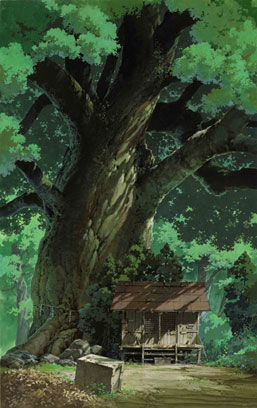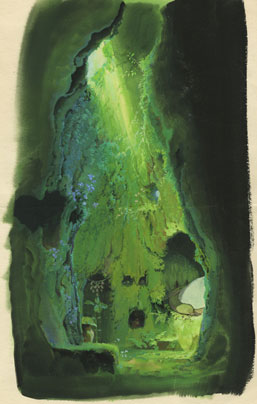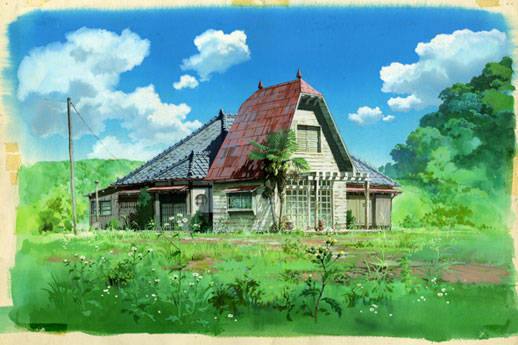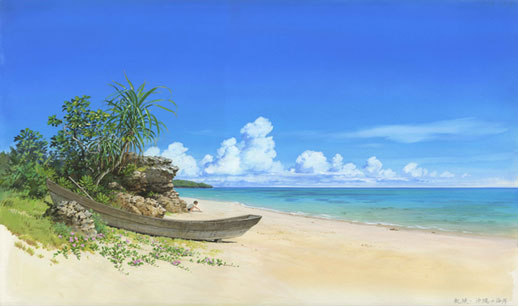Think about your favorite movies. Why are Tim Burton's films so eerie? What made Fight Club seem so grungy? Where was 300 filmed? Why do people still exalt and praise the direction of the Lord of the Rings trilogy? Mainly: why do adventure and fantasy movies transport your imagination to exotic locales?
Backgrounds are a subtle thing. Settings are often overlooked. Without carefully planned landscapes, films would never have their desired effect. I'm writing this post to bring the art of setting and placement from the background to the foreground (I'm such a wit). One of these elusive masters of illusion is Kazuo Oga.
This image below is one that I finished at the beginning of this year -- a result of a moment of inspiration after glancing at Oga's published art book. It was created with a tablet through Corel Painter and then filtered and adjusted in Photoshop.
(I think you can click to enlarge and see the actual image?)
Despite his incredible contribution to the art of animation and film direction, the Wikipedia (source 1) page on Oga only has one line of text which states:
Kazuo Oga (男鹿 和雄 Oga Kazuo, born 29 February 1952 in Akita Prefecture, Japan) is an art director and background artist for many Studio Ghibli anime films. He also published two artbooks and directed an OVA.


My Neighbor Totoro preliminary background
Photo © 1988 Nibariki, G; Courtesy of Museum of Contemporary Art, Tokyo

My Neighbor Totoro completed background
Photo © 1988 Nibariki, G; Courtesy of Museum of Contemporary Art, Tokyo

Howl's Moving Castle completed background
Photo © 2004; Courtesy of Studio Ghibli Productions
Instead of using acrylics or even painting digitally, Oga is very much of a traditional artist. His innovative way of painting backgrounds has been emulated and applied by many studios and may fellow background artists have adopted his methods. He describes his methods on Conceptart.org (source 3):
Basically, I use poster-color. Because as we have to paint much, we can't use expensive paint. Poster colors can show brightness or depth of color and, above all, it is easy-to-use. Talking about brushes, I use only two kinds of brushes, hira-fude (flat brush) and sakuyo-fude (pointed brush). For example, a sky or feathering clouds, misty distant mountains, rocks, plants… everything rough is done only by this large hira-fude. Old TV series anime used to be done in this way only. The last finish is done by sakuyo-fude carefully. I paint leaves roughly with hira-fude and add a few detailed leaves on it. Which is enough because the backgrounds of anime are shown only 3 or 4 seconds.
Usually the works are being painted on just barely bigger paper than standard A4-paper, Nicker Poster Colour used with about 30 different colors in bottles. On a wet paper first the basic color surfaces and tones are being painted with a bigger brush, after which you move on to smaller details little by little. Also the straight lines are being painted with a brush, taking support from a ruler and a stick gliding on its groove. A paintbrush is used only very seldom to achieve some certain effects, still most of the painting is done with a traditional brush. Hair-dryers are also being used for drying the painting when needed.

Stuffed Totoro and art print, corner exhibit
Photo © 2007; Courtesy of Museum of Contemporary Art, Tokyo
Despite being in the background, Oga is definitely not an unknown name in the art world -- in Japan he is somewhat of a celebrity. The Museum of Contemporary Art in Tokyo created an exhibit in 2007 entitled "The One Who Painted Totoro". The weekend crowds usually resulted in a jam-packed 40-minute wait outside of the museum for entrance and a subsequent 1-hour run through. The exhibit was on a nationwide tour in Japan until 2009. The above image was a portion of that exhibition.
Though he left Studio Ghibli in 1994 to be a freelance artist, Oga's decades of dedication to the studio are evident until this day. I believe his style has become part of the Ghibli brand. In the latest film, Ponyo, the entire background setting was hand-drawn and the animation was filled in through filters. Despite Oga's lack of involvement in the direction of this film, the landscape art was a blatant tribute to his work during his time at Ghibli.

Ponyo on the Cliff by the Sea art book
Photo © 2010; Courtesy of Hayao Miyazaki

Ponyo on the Cliff by the Sea art book
Photo © 2010; Courtesy of Hayao Miyazaki

Kazuo Oga, art book
Photo © 1995; Courtesy of Kazuo Oga

No comments:
Post a Comment